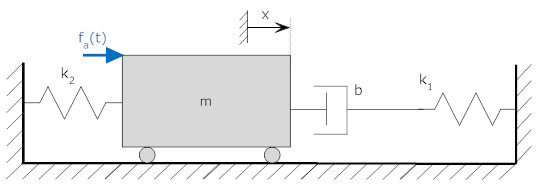Transformation: Single Diff Eq ↔ Transfer Function
Contents
Single Differential Equation
to Transfer Function
If a system is represented by a single nth order differential
equation, it is easy to represent it in transfer function form. Starting
with a third order differential equation with x(t) as input and y(t) as output.

To find the transfer function, first take the Laplace
Transform of the differential equation (with zero initial conditions).
Recall that differentiation in the time domain is equivalent to multiplication
by "s" in the Laplace domain.

The transfer function is then the ratio of output to input
and is often called H(s).

Note: This notation takes increasing subscripts for the an
and bn coefficients as the power of s (or order of derivative
decreases) while some references use decreasing subscripts with decreasing
power. This notation was chosen here in part because it is consistent with
MatLab's use.
For the general case of an nth order differential equation with m
derivatives of the input (superscripted numbers in parentheses indicate the
order of the derivative):

This can be written in even more compact notation:

Transfer Function to Single
Differential Equation
Going from a transfer function to a single nth order differential equation is
equally straightforward; the procedure is simply reversed.
Starting with a third order transfer function with x(t) as input and y(t) as
output.

To find the transfer function, first write an equation for
X(s) and Y(s), and then take the inverse Laplace Transform. Recall that
multiplication by "s" in the Laplace domain is
equivalent to differentiation in the time domain.

For the general case of an nth order transfer function:

This can be written in even more compact notation:

Example: Transforming Between Single Differential Equation
and Transfer Function
Example: Single Differential Equation to Transfer Function
Consider the system shown with fa(t) as input and x(t) as
output.

The system is represented by the
differential equation:

Find the transfer function relating x(t) to fa(t).
Solution: Take the Laplace Transform of both equations
with zero initial conditions (so derivatives in time are replaced by
multiplications by "s" in the Laplace domain).

Now solve for the ration of X(s) to Fa(s) (i.e, the ration of
output to input). This is the transfer function.

Example: Transfer Function to Single Differential
Equation
Find the differential equation that represents the system with transfer
function:

Solution: Separate the
equation so that the output terms, X(s), are on the left and the input
terms, Fa(s), are on the right. Make sure there are only positive
powers of s.

Now take the inverse Laplace Transform (so
multiplications by "s" in the Laplace domain are replaced by
derivatives in time).

References














